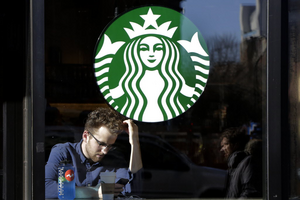How a Starbucks barista made one deaf man's day
A barista's attempt to learn American Sign Language to communicate with a regular customer highlights the deaf community's challenges. But technology is also breaking down barriers.

A man sits inside a Starbucks, in New York. Starbucks is changing the terms of its rewards program so that people who just get a regular cup of coffee will have to spend significantly more to earn a freebie, Jan. 11. A story about a Starbucks barista learning American Sign Language to accommodate deaf regulars went viral this week.
Mark Lennihan/AP/File
When Ibby Piracha headed into Starbucks for his usual caramel Frappuccino last week, the barista asked him, "What do you want to drink?"
Mr. Piracha, who is deaf, did a double take. Although most coffee shop customers hear that question every day, he'd never before had a Starbucks employee ask it in American Sign Language, or ASL.
"I've been learning ASL just so you can have the same experience as everyone else," Leesburg, Va., barista Krystal Piotrowski-Payne wrote in a note to him, which he then shared in a Facebook post "liked" more than 14,000 times.
For Piracha, who usually types out his order on his phone, the gesture meant much more than a cup of coffee.
"She was saying she looked on YouTube because she had a lot of customers that came in using text. I was very surprised she was willing to learn [sign language] and it shows she respects deaf people ... She's an inspiration," he told ABC News.
For hearing-impaired Americans, typical interactions with non-ASL users can be challenging enough. Uninformed reactions, from shouting at a deaf person, to speaking comically slowly, make it even worse, some say. Just days before his latest experience at Starbucks, which he visits several times a week, Piracha shared a Twitter post with advice for non-ASL users:
"We’re deaf, yelling at us doesn’t do anything (other than make yourself look like a moron). Most deaf people are natural lip-readers, so speak naturally. Don’t over-exaggerate your words, or raise your voice and talk to us like we’re mentally challenged."
Attitudes like Ms. Piotrowski-Payne's go a long way to bridging that divide. But on a daily basis, deaf Americans today also use mobile technology to facilitate communication in ways that, while far from perfect, go far beyond older generations' opportunities.
Smartphone "technology is an everyday savior in my life," Michelle Dunn, who is deaf and works at a school for the deaf, told the Boston Globe in 2012. Texting and voice-to-text services have reduced the community's reliance on bulkier, stationary TTY machines, and go wherever their users do.
But some of the most important advances do more to bolster relationships within the deaf community rather than connect deaf individuals to the hearing world. Video chats, for example, let friends sign together. Text-based services mean they have to communicate in English. ASL is its own language, not 'English with signs;' it has its own grammar and culture, one reason many deaf parents worry that cochlear implants, which can help improve hearing, could erode the deaf community's strong identity.
"When I can communicate in my first language, which is sign language, it’s so much more convenient, because this is my culture," Samantha Perry told the Globe. "Facial expressions, grammar, body language – I have the ability to express myself more freely when it’s visually on a screen. If I had to do it in text, I’d feel more limited."
One Polish teen's app, Five, promises to make texting more natural for ASL users, too. Five, which was originally designed for hip-hop fans to send each other hand gestures, will let users create their own custom signing symbols, opening a new chapter in deaf phone users' possibilities.
"Currently, there are no messaging apps for deaf people because I think that the majority of entrepreneurs don’t know about the problems of deaf people," CEO Mateusz Mach told Voice of America.
Four million Americans have some form of hearing impairment, and perhaps one-eighth are deaf in both ears. But for most people, it's an invisible community, and gestures meant to bridge the hearing and non-hearing worlds, like the barista's are rare, in Piracha's experience.
"I even told the Starbucks manager, 'You know, I was very impressed by your employee,' " he told ABC.

